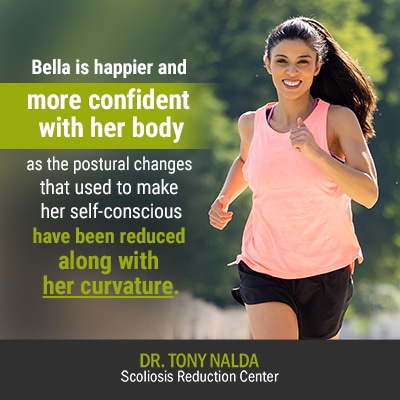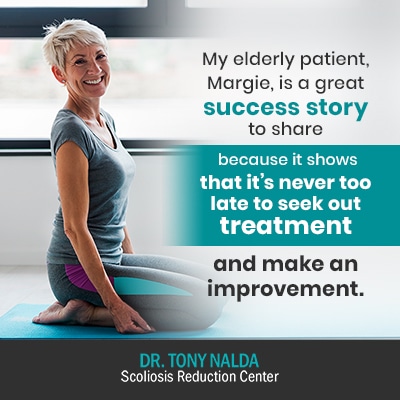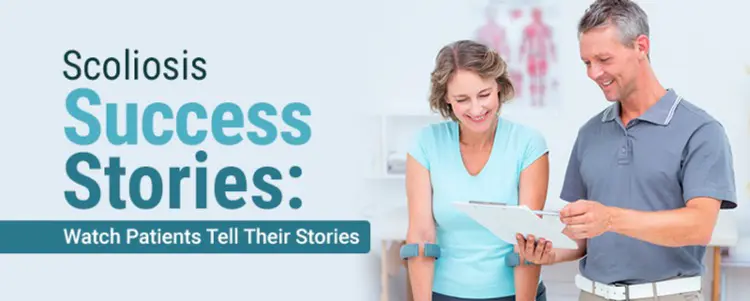Scoliosis is a highly-variable condition that can develop at any age and with different severity levels. That’s why it’s so important for effective treatment to be scoliosis-specific and customized to suit the unique patient and condition characteristics shaping each case. No two patients will experience their condition in exactly the same way, which is why it can be so beneficial to listen to patients sharing the benchmarks of their scoliosis journeys.
Scoliosis success stories can be a great resource for those recently diagnosed, or for those supporting a loved one recently diagnosed. We all have a story to tell, and through patients sharing their scoliosis journeys, we can open up a dialogue by shedding light on what it’s like to live with, and treat, scoliosis.
We spend a lot of time discussing the specifics of diagnosis and treatment, which is informative, but what is it really like to face life with scoliosis? Only my patients can tell us that, so I’ve collected some experiences to share and spread a better collective understanding of the condition, and my treatment process.
The Importance of Scoliosis Success Stories
Being diagnosed with an incurable progressive spinal condition, like scoliosis, can add a lot of stress and uncertainty into a person’s life.
Feelings of powerlessness and a loss of control over one’s own body can be emotionally debilitating, and when physical symptoms start to develop, it can be hard to stay positive about life’s possibilities.
For family members, especially parents of loved ones recently diagnosed, there are also a lot of difficult emotions to grapple with. Wanting to say the right things, do the right things, somehow lessen the loved one’s burden, but having little ability to do so, can feel all-consuming.
I’m here to tell patients and their families that there are lots of resources in terms of support and answers, and there is always hope: hope for empowerment, treatment success, and hope for the future. The stories I’ve chosen to share do just that, they spread hope.
In addition, these stories show that sometimes the best way to support a loved one is to advocate for them by making sure every treatment option is being explored and that they aren’t being passively funneled in one direction.
Here at the Scoliosis Reduction Center®, I make it a priority to spend as much time answering questions as each patient needs. I want them to fully understand the treatment process, as well as where a condition can end up if not treated proactively, or by an approach that doesn’t prioritize function.
As scoliosis can affect all ages from infants to the elderly, let’s start with Abby, a story of child scoliosis.
Child Scoliosis Success Story: Abby
When Abby was diagnosed at the age of 6, she was already at a 48-degree curve, which put her in the ‘severe scoliosis’ classification.
Abby’s mom was shocked by the discovery and, like many parents, felt like it came out of nowhere. She was frustrated by the orthopedic response of bracing, with little guidance other than that, and likely surgery.
Abby’s mom was thrilled when I took the time to present and explain a different path of treatment: an effective conservative program that has the potential to reduce the curve without surgery.
Within three months of treatment here at the Center, Abby’s curvature was reduced from 48 to 30 degrees, and the plan is not to stop there; we will continue working towards reducing it further.
The goal is to get her under 20, or even 10 degrees, and then wean her off active treatment and monitor her as she approaches and goes through adolescence.
Abby’s full success story can be found here.
Adolescent Idiopathic Scoliosis Success Story: Taylor
When Taylor was just over 11 years old, a regular pediatric check up and an Adam’s forward bend test revealed that Taylor had scoliosis, and was already past the surgical-level threshold with a 50-degree curve.
However, surgery wasn’t an option for Kristen, Taylor’s mom, who felt that an invasive procedure should be avoided if there was another option available.
Kristen heard about CLEAR treatment through her chiropractor, who told her to come see me. After explaining what could happen with a curvature that was already at 50 degrees, prior to going through the growth and development that was coming, and how quickly it could become an 80, 90-degree curve, I got to work designing a customized treatment plan.
After intensive care, we were able to reduce Taylor’s curve down to 36 degrees in a short period of time, and throughout growth, we were able to manage her progression effectively.
Through modified bracing and therapy, we were able to keep her curvature down and help her spine resist the condition’s progressive force.
This is Taylor’s full scoliosis success story.
Adolescent Idiopathic Scoliosis Success Story: Bella
When Bella went for a routine sports physical at the age of 12, she was told she had a minor abnormal spinal curvature, but that it “wasn’t that bad.”
At the time, Bella didn’t even know what scoliosis was. When Bella’s mom, Stephanie, took Bella’s X-rays into an orthopedic doctor, she was told that Bella should wear a Boston brace at night and be scheduled for spinal-fusion surgery.
Stephanie did her due diligence researching other options and stumbled upon the CLEAR Scoliosis Institute.

With a 50-degree curve and a Risser score of 0, we knew Bella still had a lot of growing to do. In fact, at the time of diagnosis, Bella had grown 5 inches in a year.
With adolescent idiopathic scoliosis, because of growth and progression, we really want to reduce curvatures and hold them there through the rapid-progression phase of puberty, and this worked with Bella.
We took a potentially severe curvature, stopped it from becoming very severe, and were able to reduce it down from 44 to 39 degrees.
The goal is to continue reducing the curve and put a dent in the condition’s progressive line so surgery can be avoided.
Bella is happier and more confident with her body as the postural changes that used to make her self-conscious have been reduced along with her curvature.
Listen to Bella’s inspirational success story here.
Adult Scoliosis Success Story: Scott
My adult patient, Scott, is an active family man. When his back pain kept getting worse and started keeping him from the activities he loved, he was diagnosed with mild scoliosis.
He first got general chiropractic care for his scoliosis, which helped in managing related pain, but was doing little to impact his scoliosis on a structural level.
When his symptoms increased to the point where he could no longer pick up his kids and lead an active lifestyle, he was referred to me.
Adult curves compress because of gravity, and compression can make cases of adult scoliosis very painful; their spines aren’t lengthening as they are in children and adolescents, which counteracts compression and pain.
Even though Scott’s curvature was relatively mild, compared to some, it was very painful and debilitating for him. Scott had multiple curves, and through my treatment approach here at the Center, we were able to reduce his curvatures to less than 10 degrees.
I like this patient success story because it shows how a lot of the time, curvature reduction isn’t just about age, but more to do with commitment. Some of my best treatment-success stories are with adults because they take treatment seriously and fully commit; Scott was one of those patients who worked hard.
Thanks to Scott’s hard work and dedication, plus a proactive treatment plan, his quality of life is back. He can play sports, pick up his kids, and that makes me very happy to see.
Scott’s inspirational scoliosis journey can be found here.
Elderly Scoliosis Success Story: Margie

My elderly patient, Margie, is a great success story to share because it shows that it’s never too late to seek out treatment and make an improvement.
Margie’s daughter first noticed that her mother’s back seemed, what she thought, was swollen. After Margie was diagnosed with a 45-degree lumbar curve, she made her way here to the Center, where I discovered she also had a huge kyphosis of 80 degrees.
The problem with scoliosis in the later stages of life is that it can progress rapidly and the spine’s overall function can deteriorate as rapidly, to the point of the spine becoming unfunctional.
Through an intensive and modified treatment plan that included home therapy, home rehabilitation, and designing a brace that was tolerable for Margie to wear because it didn’t squeeze her spine, but pushed it, she’s now on the path of stabilization.
We were able to reduce her scoliotic curve from 45 to 39 degrees and her kyphosis from 80 degrees to 67.
Margie can now return to her gardening, feels better about her posture, and is thrilled with the results and the possibility of a brighter future.
Margie’s success story can be found here.
Conclusion
I love sharing scoliosis success stories. Not only am I proud to be a part of these patients’ scoliosis journeys, but I also want other patients who have been recently diagnosed to know there is always hope.
I want patients, and their families, to be empowered by the knowledge that they have choices, and to understand how those different choices carry different potential outcomes.
For those who choose to forego spinal-fusion surgery or want to explore a less-invasive option, the functional chiropractic-centered approach I offer patients here at the Scoliosis Reduction Center® can bring about amazing changes.
I’ve seen what patients are capable of achieving through commitment to a proactive and functional treatment plan, and I am so proud to be able to share these stories of success and inspiration with others, as well as encourage those recently diagnosed to become one of our future success stories.





